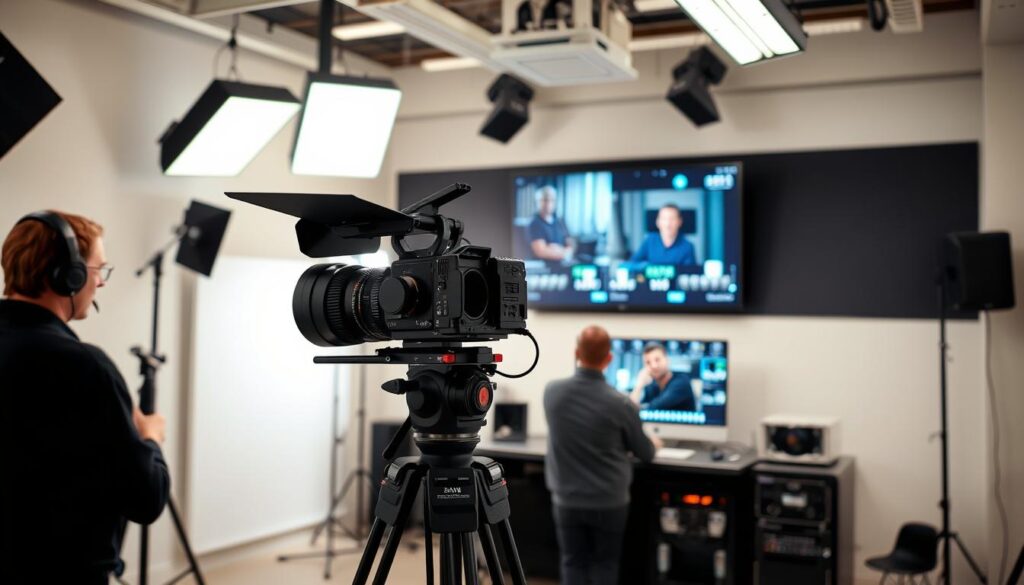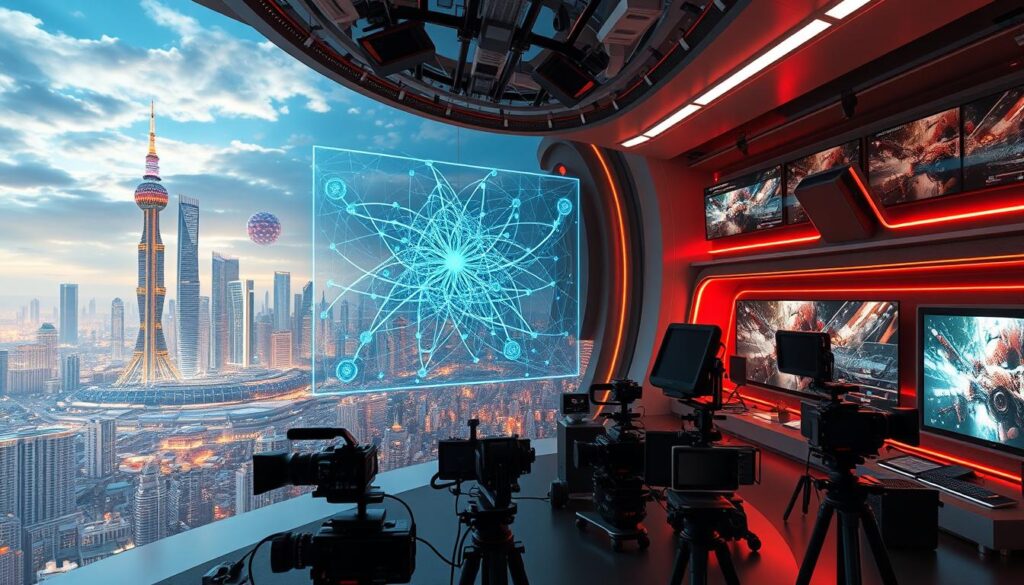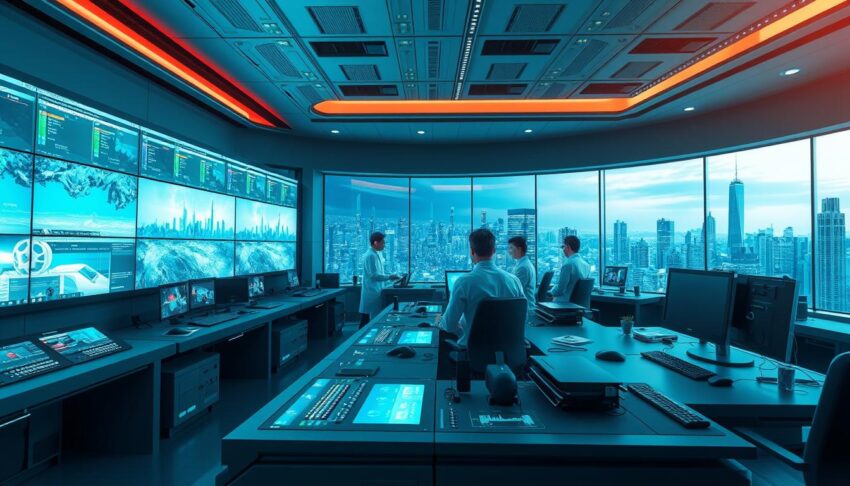In today's digital world, automated video production is changing the game for creators. Old methods can take 4 to 8 weeks, from planning to editing. But with tools like Wideo.co, creators can make videos in minutes or days.
This lets them spend more time on creativity and less on boring tasks like encoding. It's a big win for anyone making videos.
Automated video production makes things more efficient and keeps video quality high. Wideo.co lets users make many videos at once with batch processing. It also has pre-made templates to save time.
It's easy to use, even for those who aren't tech-savvy. As more content is needed, using automated tools is key to success.
Key Takeaways
- Automating video production significantly reduces time from weeks to minutes.
- Platforms like Wideo.co facilitate batch processing for increased efficiency.
- Pre-designed templates streamline the video creation process.
- Automation minimizes the need for manual editing, making it user-friendly.
- Modern tools are essential for meeting rising content demands.
Understanding Video Production Workflow
The video production workflow is key to a project's success. It outlines the steps from the first idea to when the video is shared. It's divided into four main stages: pre-production, production, post-production, and delivery.
In the pre-production phase, important tasks include setting a budget and planning the timeline. You also write the script, cast actors, and plan your equipment. This stage is crucial and can take up to 30% of the project's time.
The production stage is when the team captures the footage. This can take anywhere from a few minutes to months, depending on the project. Tracking progress is key to staying on schedule.
After production, the post-production stage begins. Here, you organize the footage, edit the video, and choose the music. This stage has seven key steps to ensure the final product is top-notch. Following these steps carefully is vital for quality.
Having a clear video production workflow helps manage budgets and predict costs. It reduces delays, improves teamwork, and enhances communication. A well-organized workflow is essential for creating quality video content.
Key Benefits of Automated Video Production
Automated video production brings many advantages to businesses. It makes creating content more efficient. Tools like Adobe Premiere Pro with Sensei AI automate editing, saving a lot of time. This lets creators work on more important tasks.
It also helps cut costs. Platforms like Descript and Runway ML offer plans starting at $12 a month. This makes advanced video tools affordable. AI tools help avoid mistakes, keeping costs down.
Automation boosts productivity too. It lets businesses make many videos from one template. This way, they can grow without losing quality. Teams spend less time on tech and more on creativity.
Using video in marketing is becoming more popular. Companies that use video grow faster and engage more. Marketing with automated video can see a 30% boost in engagement. As video demand grows, so do the benefits of automated production.
The Role of Pre-Production in Video Automation
The pre-production process is key to any video project's success. It involves writing scripts, planning scenes, and setting up logistics. This phase is crucial for video automation.
AI tools make this process better by creating unique ideas for brands quickly. This cuts down brainstorming time, making the start of video creation smoother. AI also helps predict costs and plan schedules, which can save up to 30% on budgets.
In pre-production, making smart choices is vital. AI helps find the right vendors, cutting hiring time in half. Freelancers can write scripts faster with AI, speeding up idea development by 40%. AI also makes storyboarding quicker, saving 35% of time.
AI automates tasks, freeing up to 20% of a freelancer's time for creativity. It also gives insights to improve creative direction, boosting project success by 25%. This helps maintain professionalism and consistency in pitches, making a bigger impact.
AI enhances collaboration in planning. It reduces misunderstandings and revisions by 30%, making workflows more efficient. AI analyzes scripts and storyboards to see what works best with audiences. This ensures a smooth transition to production, setting the stage for successful video automation.
Using Technology to Enhance Video Production Efficiency
The world of video production is changing fast, thanks to new tech. Using technology is key for filmmakers to work better and faster. Tools like AI video editing software and other efficiency tools have changed how we make videos.
AI can now quickly analyze and edit videos, saving a lot of time. It can cut editing time by up to 50%. This lets filmmakers spend more time on creative work, not just editing.
Tools like Adobe Premiere Pro’s Auto Reframe show how automation helps. It changes video sizes for different platforms, making videos more engaging. This can increase social media video views by 60%.
AI also improves video quality by adjusting colors. This can make videos 30% more interesting to watch. Better audio, thanks to AI, can make videos 40% clearer, keeping viewers interested.
AI makes audio better by reducing noise and leveling sounds. This can make audio 40% clearer, which is key for keeping viewers. AI also helps with visual effects, making them 70% more precise.
AI in video production is growing fast, at 25% a year. This shows a big trend towards making marketing more efficient. By using these tools, filmmakers can work 35% faster, finishing projects quicker.
Cloud tools help teams work together from anywhere, which is important today. They also make it possible to work faster. Soon, we'll have tools that can translate languages in real-time, making production even more efficient.
With more people wanting to see videos from brands, using automation is key. It helps meet this growing demand.

Automated Video Production: Tools and Software
Video production tools have changed a lot in recent years. Automated video software has made things easier for creators. For example, Veed offers automated subtitles and captions. It starts at free and goes up to $70 a month, giving users full control.
Kapwing lets you edit videos with text, cutting down editing time to minutes. This makes it a top choice for automated video editing. Wisecut also helps with editing, offering auto-cutting and bulk uploads. Prices range from $0 to $57 a month, making it budget-friendly.
Opus helps turn long videos into short ones, starting at $19 a month. It includes a free plan for 60 minutes of video a month. HeyGen offers AI avatars and voice cloning for $29 a month, with a free trial.
Runway is great for teamwork, with editing features and real-time collaboration. Prices range from $0 to $100 a month. Plainly API lets you make over 1000 unique videos daily, with prices from $0 to $599 based on needs.
AI is becoming more common in these tools, making video production faster and more efficient. Users find they can finish projects quicker. Learning about these tools can make your production workflow better and faster.
AI Video Editing: Transforming Your Video Content
AI video editing is changing how we make videos. Automated tools help arrange footage quickly, saving time. AI platforms can even make videos from scripts, making content creation faster.
Machine learning has made video production easier. AI tools help with scriptwriting and storyboarding. For example, ScriptBook analyzes scripts to see if they'll do well in the market.
AI is also changing how we film. Drones and robotic cameras take steady shots, even in complex scenes. They also help directors adjust lighting and actor performances on the spot.
In editing, AI tools like Adobe Sensei and DaVinci Resolve make things easier. They remove pauses and filler words, improving video quality. This also saves time on client reviews and final cuts.
AI can also add captions in over 80 languages, reaching more people. Videos that took weeks to make can now be done in hours. This lets creators meet market demands quickly.
AI and video editing together make creating videos more efficient and creative. With advanced algorithms, users can make videos that appeal to many. This new era of content creation opens up exciting opportunities for innovation and teamwork.
Steps to Implement Video Production Automation
Starting video automation can make your video production much more efficient. First, look at your current workflows to find manual and time-wasting steps. This helps you know where to start automating.
After finding these areas, create a plan that fits your needs. Use tools like the spreadsheet method for quick video creation. Choose software like Zapier or Creatomate for easy video making without coding.
It's important to train your team well for a smooth transition. Make sure they know how to use the new tools to boost productivity. Set clear goals, like making editing faster or improving teamwork, to guide your automation plan.
Remember, video automation offers more than just saving time. It also cuts costs and lets you focus on making great videos. This way, you can better meet your customers' needs.
The Future of Machine Learning in Video Production
The world of video production is about to change a lot with machine learning. This technology will make filmmaking faster and more creative. It will also make editing videos much quicker, saving a lot of time.
AI will help make content creation faster. Filmmakers can now make complex projects like trailers and music videos much quicker. This means projects that used to take days can now be done in hours.
Machine learning can also make planning shoots easier. It can take into account weather and when actors are free. This could cut down on delays by up to 25%. AI cameras can also improve video quality by checking lighting and angles in real-time.
AI editing tools will make editing scenes and cutting videos better. They could make videos clearer and more engaging by up to 50%. This could change how we make and watch videos.
But, there are also worries about using AI in video production. There are concerns about privacy and bias. It also means some jobs might change, like the need for AI scriptwriters. This shows the industry is evolving.

| Advancements in Machine Learning | Potential Impact |
|---|---|
| Automated editing tasks | Reduces editing time by up to 50% |
| Real-time feedback from AI cameras | Improves video quality by up to 40% |
| Script analysis tools | Streamlines pre-production planning significantly |
| Personalized viewing experiences | Enhances viewer engagement and retention |
| Optimization of shooting schedules | Reduces production delays by up to 25% |
AI in video production is changing the game. It's not just about making things faster. It's also making creative work more accessible to everyone, not just big companies.
Looking to the future, AI and machine learning will make video production even more exciting. Creators will have more time to focus on their vision. Technology will handle the rest.
Best Practices for Automated Video Content Creation
Using video content creation best practices is key to getting great results with automation. Good planning is essential. It helps creators know their audience and set goals for each project.
Adding automated workflow tips makes things easier. For example, using templates for different projects saves time and keeps branding consistent. Tools like Lumen5 and Vidyard make video creation fast and engaging.
Don't forget about quality checks. Automated systems can do these checks, keeping content fresh and on brand. Feedback loops are also important. They help improve future projects based on what viewers like.
Automation lets you make many video versions quickly. With one template, you can make hundreds of videos fast. This is hard to do by hand in a short time.
Analytics tools track how well your videos do. This data helps improve your video strategy. By automating video production, businesses can save money and make more videos without losing quality.
Conclusion
Automated video production has changed the game in video creation. AI tools have made things more efficient and cheaper. They cut down editing time and improve planning before you start.
These tools let creators make great content without losing their vision. They make video production easier for everyone.
Now, more people can make videos thanks to tools like Adobe Premiere Pro and Kapwing. This means marketers and companies can make videos that really speak to their audience. They can use data to make videos that hit the mark every time.
AI and human creativity working together is key. AI helps a lot, but telling stories is something only humans can do. This mix of AI and human touch opens up new ways to express and innovate.
The future of video production looks bright. With AI and human creativity, we're in for some amazing changes. This is just the beginning of a new era in video making.
